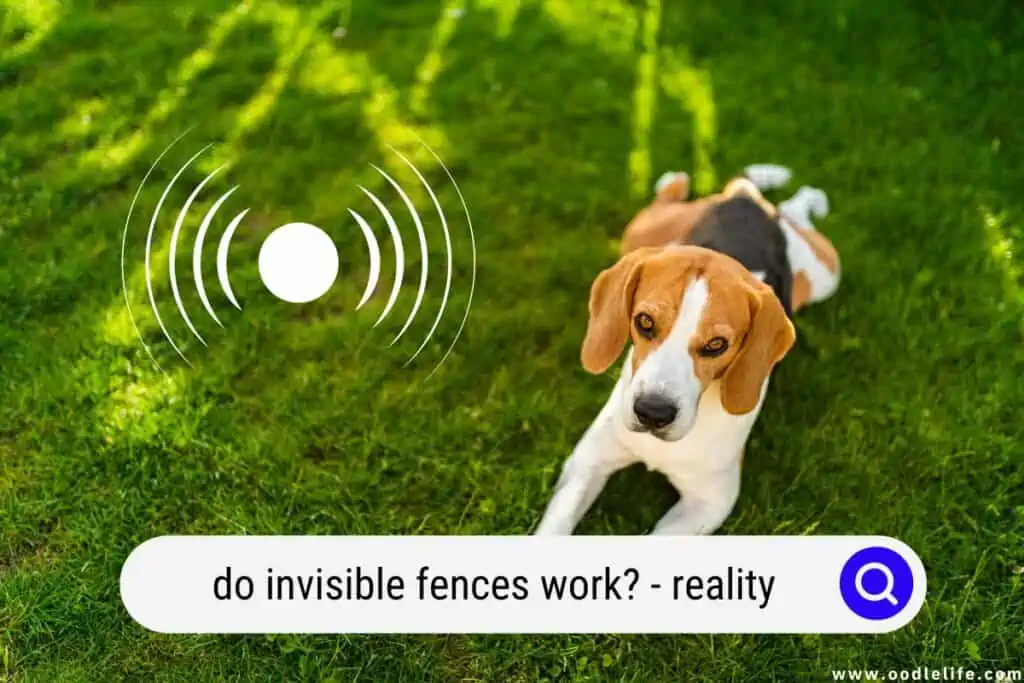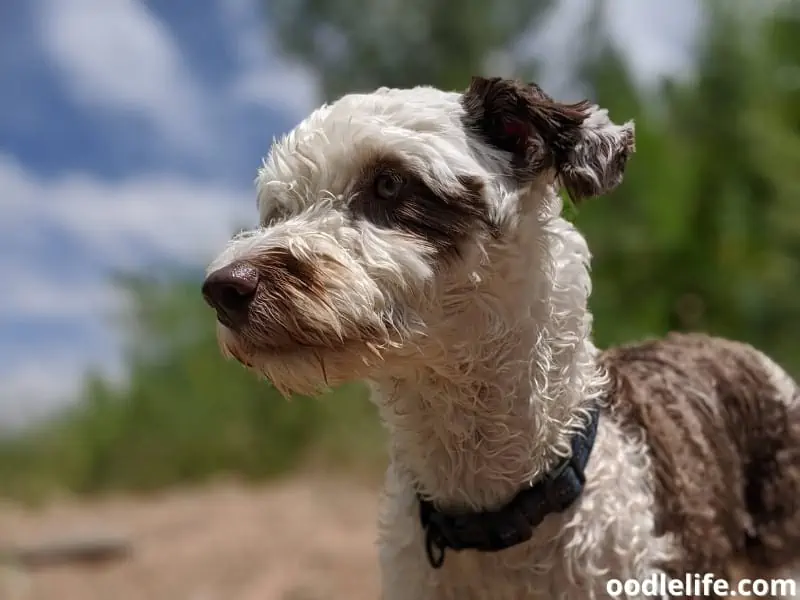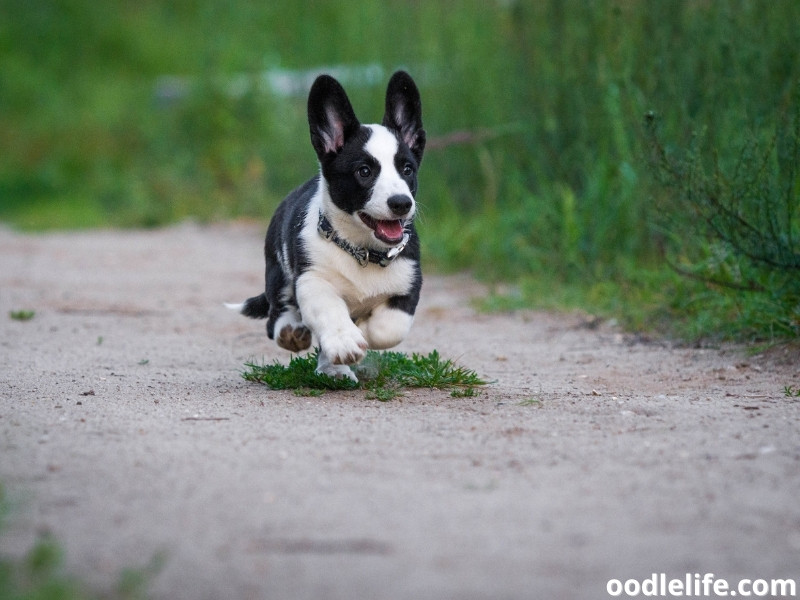Do Invisible Fences Work? (Reality)
Just about every dog owner with a fenceless yard has considered what they can do to keep their pups from wandering off. One popular option is the invisible fence, which uses electrical shocks to create a boundary around the yard.
But do invisible fences work? Or are invisible fences another idea that looks great on paper but has serious downsides when applied, ranging from ineffectiveness to seriously affecting a dog’s psyche? The following is the lowdown on whether these devices work or if you should look at other options to keep your pet safe.

What Qualifies as an Invisible Fence?
For this article, the invisible fence discussed comprises the following:
- Border created by a buried wire
- Transmitter
- A receiver that produces audible signals and electric shocks when activated.

The fence helps train dogs to stay within a boundary by delivering a warning beep when they approach a perimeter (the buried wire) and a shock if they try to cross that perimeter. Both the noise and shock are adjustable based on the degree to which either gets ignored.
Eventually, if it is effective, the dog will avoid the perimeter when they hear the noise or avoid both once they learn its boundaries.
Do Invisible Fences Work?
At its most basic, the answer to that question is a qualified “yes.”
In the most technical sense, an invisible fence will restrain a dog in a typical setting provided the device is used correctly, with sufficient noise and electrical shock level. However, there are several instances when the invisible fence will not work or might not function as you planned.
When the Fence Gets Severed
If you have landscapers, municipal workers, or even family members digging in the yard where your fence has been buried, they might sever the wire with a spade, shovel, or machinery. Depending on the type of invisible fence, it will either stop working or be restricted to the point of the severing point.

Either way, most dogs are likely to figure out that part or all of the fence is not working out and run off.
Some Dogs Do Not Feel the Shock
Thick-furred dogs sometimes do not feel the shock like their short-haired counterparts, making the fence less effective.

Some dogs have fur that is so thick that they barely feel anything at all and certainly do not feel enough to modify their behavior. You can increase the level of shock, but doing so is unlikely to do little or no good.
Dogs Can Forget in the Heat of the Moment
Dogs are often instinctual, leading them to do things without thinking. If a dog gets stimulated to chase something, like a deer, they might run through an invisible fence as a reflexive action. Likewise, they’ll do the same thing if they get excited because they see someone they want to greet.

That leads to a few possible outcomes for a dog:
- Gets shocked and associates that with something they like (such as greeting you).
- Is shocked but still manages to get outside the fence.
- Learns they can endure the shock if the end result is getting to something or someone they like.
In the first scenario, the association has the potential to create a lasting fear in your pooch whenever that stimulus appears. While the fence works in the last two scenarios, the dog still gets away.
Some Dogs Just Do Not Care
Just like some people break the law knowing the consequences if they get caught, a few dogs care little about the noise or the shock. They bull through, endure the momentary discomfort, and get on with having fun regardless of the sensation. Once the dog realizes they can bear the shock, the fence is practically useless unless you raise the shock level.

With some dogs, that still won’t be enough as they are simply not sufficiently affected by the noise and shock to modify their behavior.
In those cases, there is little that you can do to make the invisible fence more effective (or even practical in the first place). Where the shock is insufficient, the fence is functionally useless once the dog learns nothing will happen if they leave.
Some Dogs Become Fearful and Obsessed
While most dogs learn the boundaries of an invisible fence and adapt their behavior to avoid the noise and the shock, some get very fearful of the experience. They might associate the shock with going outside or be so afraid to move around your backyard that they do nothing but sit down.

In turn, those fear responses could affect other aspects of their lives away from the yard and the invisible fence.
Your pet may develop a fear of going outside. Even if that extreme reaction doesn’t happen, your pup may no longer enjoy certain outdoor activities, like chasing a ball or playing fetch. In some cases, walking them may become a struggle because they fear being shocked the entire time they are outside.
Fences Fail When Batteries Fail
Another risk is the potential for the batteries in the collar to fail. When that happens, the invisible fence will not work. Unless you are super-diligent, your dog will likely be the one that discovers the batteries are dead if they try to cross the boundary of the fence.

Some pups figure out dead batteries mean a nonfunctional fence and proceed to constantly test the boundaries. When they hear the warning noise, they back off and check it later until no noise is activated.
Moreover, there are reports of dogs realizing that noise activation drains the batteries. So, with time and patience, these industrious pooches discovered that the noise would eventually disappear if they sat in the activation zone. And, when it did, they could proceed past the boundary.
The Shock Causes Aggression
One goal of an invisible fence is to keep the dog inside it. With most animals, a shock or two during training teaches them to stay away from the boundary. Unfortunately, for a few pooches, the shock could actually make them more aggressive.

Aggressive behavior in this form often happens when the dog associates the shock with a threat and something that is happening when it gets shocked.
For example, if Fido is shocked when they start to chase a squirrel, they may associate the shock with the squirrel. That could lead their instincts to put them in attack mode. Or they might connect the sensation to a passerby and conclude that all strangers will shock them.
Unfortunately, when that happens, there is the potential for a dog to conclude unfamiliar humans in any setting are a threat.
Should You Get an Invisible Fence?
So, do Invisible fences? They can certainly play a role in training a dog to respect yard boundaries. However, sometimes they don’t work and may create more problems for owners.
In most cases, the training is momentarily unpleasant but leads to the dog staying in the confined space.
Of course, there is always the possibility a very smart dog learns to outsmart the fence and you. Whether you should get one depends on whether you are willing to risk the potential negative consequences while attempting to make your beloved pet as safe as possible.